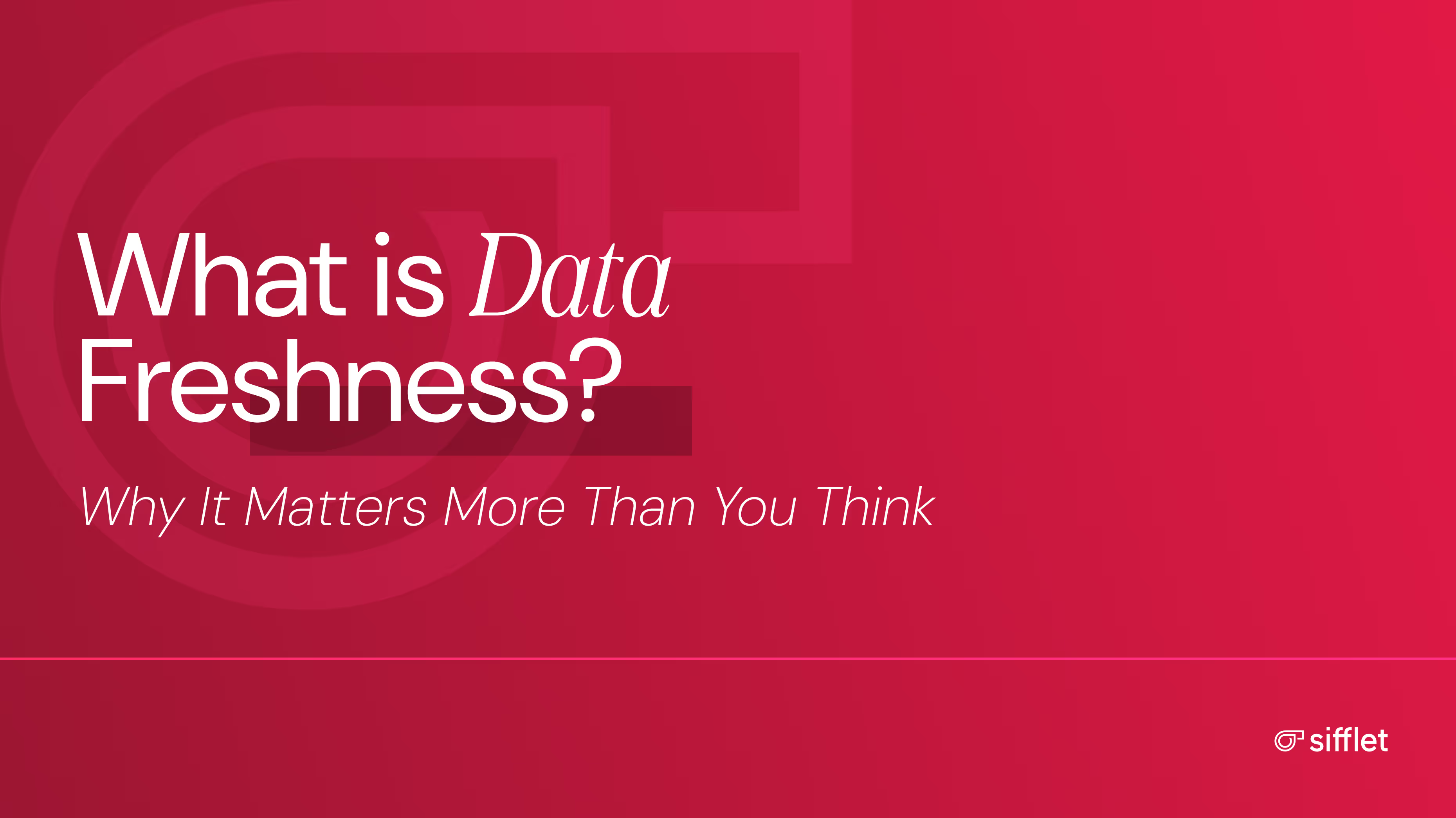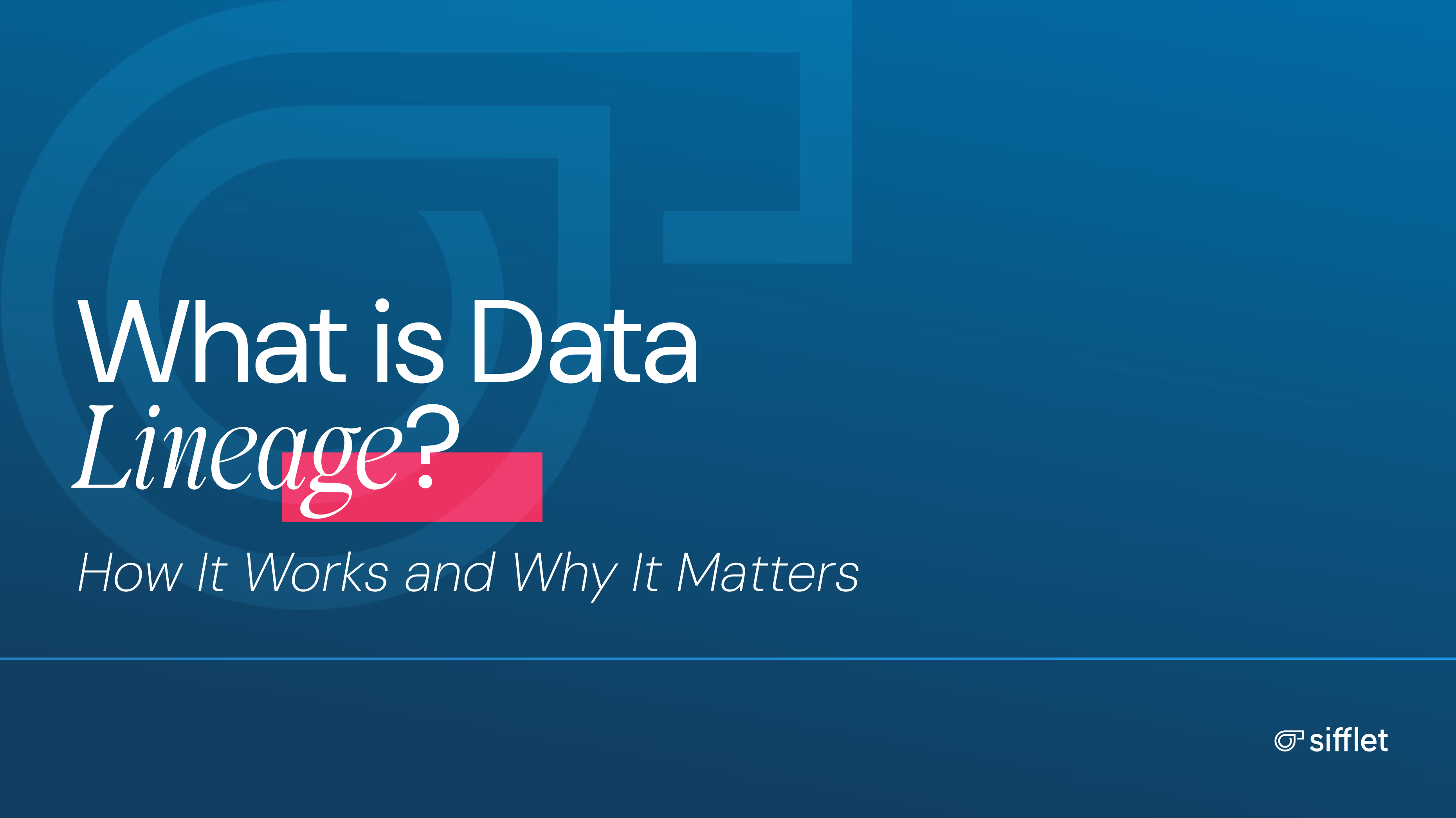85% of companies have reported that outdated data can lead to revenue loss.
Stale data negatively impacts every department in every company, and while some may spend hours looking for the reason or someone to blame, there is only one culprit.
Having a data observability tool will guarantee to protect your data freshness, helping you understand what your data looks like, and when it's actually usable for business decisions.
What is Data Freshness?
Data freshness defines how current your data is. It measures the interval between when data is generates and when it is available for analysis or operational use.
Data freshness is an important factor of data reliability and data observability. It ensures that insights, dashboards, and AI models are based on the latest available data rather than outdated information.
Poor data freshness can lead to delayed decisions, missed opportunities, and mistrust in analytical outputs.
Along with schema, lineage, volume, and distribution, data freshness is one of the 5 pillars of data observability.
Fresh vs. Fast: Freshness, Timeliness, Recency, and Latency
Before diving deeper, let's clear up some common confusion.
Data professionals often use "freshness," "timeliness," "recency," and "latency" interchangeably, but each concept serves a distinct purpose:
Another way to think about it: A weather report from two hours ago might be timely (it arrived when expected) and recent (created today), but it's not fresh enough to tell you if it's currently raining outside.
Understanding these distinctions matters because each requires different monitoring approaches and has different business implications.
You might tolerate high latency for batch reporting but need ultra-fresh data for real-time personalization.
This is where understanding your business logic becomes critical.
What Happens When Data Goes Stale?
Stale data doesn’t just cause technical headaches, it cascades into costly, sometimes critical business consequences.
Although data freshness can be applied to all industries, let’s take a look at 4 real examples.
In financial services, even a few minutes can be the difference between profit and peril.
On a derivatives trading desk, risk calculations hinge on real-time market data. If price feeds lag by just five minutes during volatile swings, models become dangerously outdated.
One major investment bank discovered its risk dashboard was running 20 minutes behind during peak hours, a delay that could have exposed them to millions in unhedged risk.
In healthcare, the stakes are even higher.
When patient monitoring systems lag, nurses may miss vital changes.
Delays in updating electronic health records can lead to duplicate testing, medication errors, or missed interventions. A large hospital network found its patient flow dashboard was showing bed availability from four hours earlier, triggering unnecessary transfers and emergency room gridlock.
In manufacturing, stale sensor data can silently sabotage quality.
Predictive maintenance systems rely on fresh inputs (temperature, pressure, vibration) to spot issues before they snowball.
One automotive manufacturer learned its quality alerts were based on data 30 minutes old, allowing hundreds of defective parts to slip through undetected.
In media and advertising, outdated insights drain budgets.
Real-time bidding demands instant feedback on user behavior. If audience data or conversion signals lag, spend gets misallocated.
A major streaming platform discovered its content recommendations were based on data that was six hours old, eroding user engagement.
Across industries, the pattern is clear: when data goes stale, decisions degrade. And your business pays the price.
Why Monitoring Data Freshness Matters (And Where It Breaks)
Data freshness monitoring isn't just another technical metric to track, it's a business continuity requirement.
When you monitor freshness effectively, you're essentially creating an early warning system for data-driven decisions.
The business case is straightforward: fresh data leads to confident decisions.
When executives can trust that their dashboards reflect current business conditions, they act faster and with more precision; when data scientists know their training datasets are current, their models perform better in production; and when operational teams have real-time visibility into system health, they prevent issues before they impact customers.
But freshness breaks down in predictable places throughout your data infrastructure:
- Source system delays are often the first culprit.
APIs might throttle requests, databases could be under heavy load, or external data providers might experience outages. These delays compound as they move downstream.
- Ingestion pipeline issues create bottlenecks that affect freshness.
Network connectivity problems, authentication failures, or resource constraints in your ETL processes can cause data to queue up rather than flow smoothly.
- Transformation lag happens when data processing jobs take longer than expected.
Complex transformations, inefficient queries, or competing resource demands can slow down data preparation pipelines.
- Delivery and caching problems can make fresh data appear stale to end users.
CDN caching, database replication delays, or visualization tool refresh cycles might prevent users from seeing the most current information.
The key here is that freshness problems rarely announce themselves clearly.
Unlike obvious data quality issues (like null values or format errors), stale data often looks perfectly normal, it's just outdated. This is why proactive monitoring becomes essential.
How to Monitor Data Freshness (the Right Way)
Effective freshness monitoring requires both the right metrics and the right methods.
Let's break this down practically.
What metrics should you track?
Data age is your primary freshness indicator, typically measured in minutes or hours since the data was last updated.
But context matters enormously here. Customer transaction data that's 10 minutes old might be perfectly fresh for daily sales reporting but dangerously stale for fraud detection systems.
Expected vs. actual arrival time helps you understand when your data pipelines are falling behind schedule.
If your sales data normally updates every hour but hasn't refreshed in 90 minutes, that's a freshness problem worth investigating.
Data availability windows track whether your data is available when business processes need it.
Marketing teams might need campaign performance data by 8 AM each day to make budget adjustments. If that data consistently arrives at 10 AM, it's technically timely but not fresh enough for decision-making.
What monitoring methods are available?
There are 4 possible monitoring methods you can use.
Threshold-based alerting works well for straightforward freshness requirements.
Set alerts when data age exceeds acceptable limits, but be smart about context. Weekend data delays might be acceptable for some business processes but critical for others.
Machine learning models can detect freshness anomalies by learning normal data arrival patterns and flagging deviations.
This approach works particularly well for complex data pipelines where simple thresholds might create too much noise.
Visual freshness indicators in business intelligence tools help users understand data currency at a glance.
Simple "last updated" timestamps or color-coded freshness indicators can prevent users from making decisions on stale information.
Cross-system tracing helps pinpoint exactly where freshness breaks down in complex data pipelines.
When you can trace data lineage and see processing times at each stage, root cause analysis becomes much faster.
The goal isn't perfect real-time data everywhere, it's having the right freshness for each business context, with clear visibility when things go wrong.
What Does a Freshness Incident Look Like
At a major regional bank, Monday morning started with a crisis that perfectly illustrates how freshness problems compound.
The symptoms appeared first in executive dashboards.
The CEO's daily risk summary showed identical numbers to Friday's report, which was highly unusual for a Monday after weekend trading activity.
Within an hour, the trading desk noticed their position reports hadn't updated, and customer service began fielding calls about account balances that seemed frozen from Friday afternoon.
The investigation revealed a cascade of issues.
The data engineering team discovered that their weekend batch jobs had completed successfully, but with a critical problem: the timestamp logic in their main ETL pipeline had rolled back to Friday's date due to a timezone configuration error during a Saturday maintenance window.
This meant that while new data was being processed, it was being tagged with old timestamps.
The freshness monitoring system, which relied on these timestamps, saw everything as current. Meanwhile, downstream systems were actually working with Friday's data labeled as Monday's information.
The root cause was both technical and procedural.
The timezone configuration change hadn't been tested against the data pipeline's timestamp logic. More importantly, the bank's freshness monitoring was overly simplistic. It checked whether data existed for the current date, but not whether that data actually reflected current business activity.
The resolution required both immediate fixes and longer-term improvements.
The team corrected the timezone configuration and reprocessed weekend data with proper timestamps. But they also implemented smarter freshness checks that validated data content, not just timestamps, and added cross-referencing with external market data to catch similar issues.
The business impact was significant but contained.
Trading decisions were delayed for three hours while teams verified data accuracy.
Several automated risk calculations had to be manually reviewed. Customer service handled hundreds of balance inquiry calls.
The estimated cost exceeded $200,000 in operational disruption and delayed trading opportunities.
The incident highlighted a crucial lesson: freshness monitoring must validate actual data currency, not just technical pipeline completion.
Guarantee Data Freshness with an Observability Tool
You can't ensure data freshness by setting a cron job and hoping for the best.
Modern data environments are too complex, and business requirements change too quickly for simple threshold-based monitoring.
- Effective freshness management requires proactive monitoring at every stage, from initial data ingestion through transformation pipelines to final delivery.
- Smart thresholds based on usage patterns make monitoring more relevant.
- Business-impact-focused alerts prevent notification fatigue while ensuring critical issues get attention.
The most effective approach combines technical monitoring with business context.
When freshness monitoring systems understand not just data pipeline health but also business process requirements, they can provide the right information at the right time to keep data-driven decisions flowing smoothly.
Data observability platforms allow this approach by providing visibility across your entire data ecosystem, from source systems through transformation pipelines to end-user consumption.
They help teams catch freshness issues before they impact business decisions, investigate root causes quickly when problems occur, and continuously optimize data delivery for business needs.
Want to see how modern observability helps you trust your data, minute by minute?
Watch it in action with Sifflet.





















-p-500.png)
